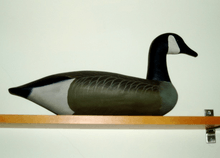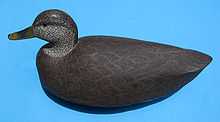Duck decoy (model)


A duck decoy is a man-made object resembling a real duck. Duck decoys are sometimes used in duck hunting to attract real ducks.
Duck decoys were historically carved from wood or cork, but modern ones are also made of canvas and plastic. They are usually painted, often elaborately and very accurately, to resemble various kinds of waterfowl.
History
Ever since Joel Barber, the first known decoy collector, started in 1918, decoys have become increasingly viewed as an important form of North American folk art. Barber's book Wild Fowl Decoys, was the first book on decoys as collectible objects. It was followed in 1965 by folk art dealer Adele Earnest's "The Art of the Decoy" and "American Bird Decoys" by collector Wm. F. Mackey.
William F. Mackey made many trips to Chincoteague Island for the great flounder fishing as well as hunting for Chincoteague decoys. On his trips to the island he called Snug Harbor Marina home. He would send out locals to search for great finds of Chincoteague history. Cigar Daisey was one of the local Chincoteaguers that would help Mackey find all the best decoys that made his collection world famous. Cigar has told many stories of the many truck loads of decoys he rounded up for his good friend.
By that time a milestone in collecting had already occurred with the publication of "Decoy Collectors Guide", a small magazine created by hobbyists Hal & Barbara Sorenson of Burlington, Iowa. The 'Guide' helped foster a sense of community and provided a forum for collectors to share their research.
By the 1970s decoys were becoming big business, at least by previous standards. The death of Wm. F. Mackey brought his decoys to market in a series of auctions in 1973 and 1974, with the star of his collection, a Long-billed Curlew by Wm. 'Bill' Bowman selling for a record US$10,500.
Since the 1960s numerous collectors organizations have been created, specialist books and magazines published, with specialist dealers, and special interest shows around the US and Canada. Canadian decoys are still believed to be the "sleepers" in the world of decoy popularity and are often undervalued but are starting to gain recognition.
The current World Record price for an antique duck decoy at auction: Red Breasted Merganser Hen by Lothrop Holmes for $856,000. Guyette & Deeter and Christie's New York. January 2007.[1]
The first million dollar price was achieved when two decoys (Canadian goose and a preening pintail drake) by A. Elmer Crowell of East Harwich, MA were said to have sold for US$1.13 million each in a private sale, in September 2007. The record-setting decoys were sold in a larger collection of 31 decoys for $7.5 million in total so it remains for a single decoy to clearly break the $1 million mark.[2]
One of the most famous decoy makers in recent times is Delbert Cigar Daisey from Chincoteague Va. Cigar decoys are in high demand all over the country. The best decoy he ever made was a pintail that he made for his wife in 1973. This decoy was featured in National Geographic in June 1980 on page 826. This decoy is estimated to be worth between $100,000 - $150,000.
Vintage factory decoys
Mason's Decoy Factory
The most famous of all factory made decoys. Operated in Detroit, Michigan, from 1896 to 1924. Produced decoys in the same style as Peterson and Dodge. Produced five grades of decoys:
- Premier Grade - two-piece, hollow body, flat bottoms, glass eyes, swirl paint on breast, notch carved bill, carved nostrils, carved nail.
- Challenge - both one piece solid and two-piece hollow bodies, flat bottoms, glass eyes, less elaborate paint on breast, no notch carved bill, lesser carved nostrils, painted black nail.
- Standard #1 or "Detroit"(glass eye) - smaller in stature, less carving, more paint detail, glass eyes.
- Standard #2 (tack eye) - smaller in stature, less carving, somewhat less paint detail, tack eyes.
- Standard #3 (painted eye) - smaller in stature, less carving, even less paint detail, painted eyes.
Other decoys
- Peterson Decoy Factory – Began in 1873 by George Peterson in Detroit, Michigan. Sold factory to Jasper Dodge in 1883.
- J.N. Dodge – Jasper N. Dodge (1829–1909) began his decoy production ca. 1883 after purchasing the George Peterson Decoy Factory. Production ceased in 1905 and closed permanently in 1908.
- William E. Pratt Manufacturing Co. – Established in 1893 in Joliet, Illinois, did not begin to produce decoys until 1921. Eventually bought out by the Animal Trap Company of America which became Victor.
- J.W. Reynolds Decoy Company – Established in Chicago, Illinois
- Swisher & Soule – Established in Decatur, Illinois.
- Hays – Established in Jefferson City, MO.
- H.A. Stevens – Harvey A. Stevens (d. 1894) began this factory in Weedsport, New York from 1880 to 1902. Harvey had several brothers that helped out at the shop, but George was the only one that would carve and paint decoys under his own label. So, the two brothers made commercial decoys and they made them during two time periods. First, the tackeye decoy made between 1870 and about 1890 and then the improved glasseye decoy made thereafter until George retired in the early 1900s. The Stevens brothers made two models, the standard decoy and the sleeper "humpback" decoy.
- Evans Factory – Walter Evans (1872–1948) was a large scale producer of fine hollow body duck decoys in Ladysmith, Wisconsin from the 1921 to 1932. Similar in appearance to the Mason Factory decoy.
- Wildfowler Decoys, Inc – Began in 1939, in Old Saybrook, Connecticut. In 1957 the company had a tragic fire that destroyed the building and most of its contents, the company was sold and moved to Quogue, New York. The company was bought by Charlie Birdsall in 1961, and moved to Point Pleasant, New Jersey. It was subsequently relocated into Babylon, New York in the mid-1970s. Occasionally, Wildfowler were contracted to produce decoys for the Abercrombie & Fitch catalog.[3]
- Herter's Inc – Popular sporting goods catalog company founded by George Leonard Herter in Waseca, Minnesota from the 1930s through 1970s.
- L.L. Bean – Sporting goods mail order company based out of Freeport, Maine produced factory decoys for a few years.
- Peterborough Canoe Company – Famed canoe manufacturer out of Peterborough, Ontario known to make solid body decoys during 'lean' canoe production seasons."
- Mintz Decoys -- Family owned business based out of Boise, Idaho and founded by master carver Don Mintz that pioneered the process of full body flocking on decoys, which creates a three-dimensional illusion and virtually eliminates all glare from the sun. Said to be far superior to regular, factory-produced decoys.
Museums and collections
- American Museum of Folk Art - New York, New York
- Barnegat Bay Decoy and Bayman's Museum - Tuckerton, New Jersey
- Birds of Vermont Museum - Huntington, Vermont
- Centerville Historical Society - Centerville, Massachusetts Elmer Crowell Collection[4]
- Charles Perdew Museum - Henry, Illinois[5]
- Core Sound Waterfowl Museum - Harker's Island, North Carolina[6]
- Havre de Grace Decoy Museum - Havre de Grace, Maryland[7]
- Lakeview Museum of Arts & Sciences - Peoria, Illinois[8]
- Milwaukee Public Museum - Milwaukee, Wisconsin
- Refuge Waterfowl Museum - Chincoteague, Virginia
- The Dorset House, Shelburne Museum - Shelburne, Vermont[9]
- Tuckerton Seaport - Tuckerton, New Jersey
- Upper Bay Museum - North East, Maryland[10]
- Ward Museum of Wildfowl Art - Salisbury, Maryland
- Wendell Gilley Museum - Southwest Harbor, Maine[11]
Festivals
- Core Sound Decoy Festival - Harkers Island, NC[12]
- Easton Waterfowl Festival - Easton, MD[13]
- Ward World Championship - Ocean City, MD[14]
- Havre de Grace's Annual Decoy & Wildlife Art Festival - Havre de Grace, MD[15]
- Ocean County Decoy & Gunning Show - Tuckerton, NJ[16]
- Thousand Islands Museum: Decoy & Wildlife Art Show - Clayton, NY[17]
- Annual Upper Bay Museum Decoy Show - North East, MD[18]
Collectors associations
- Midwest Decoy Collectors Association[19]
- Thousand Island Decoy Collectors Association[20]
- Potomac Decoy Collectors Association
- Long Island Decoy Collectors Association[21]
- Ohio Decoy Collectors and Carvers Association[22]
- New Jersey Decoy Collectors Association[23]
- Minnesota Decoy Collectors Association[24]
- East Coast Decoy Collectors Association (Maryland and Virginia area)
- Northwest Decoy Collectors Association
- Canadian Decoy & Outdoor Collectables Association.[25]
Notes
- ↑ "Bids for the birds - San Diego Union Tribune". Retrieved 2007-08-11.
- ↑ "To tune of $1.13m, decoys are the real thing". The Boston Globe. 2007-09-21. Retrieved 2007-09-21.
- ↑ Cowan, Richard; LaFountain, Richard. from "Wildfowler Decoys". Decoy Magazine. Jan./Feb. 2001
- ↑ Centerville Historical Society. Retrieved July 9, 2012.
- ↑ Charles Perdew Museum. Retrieved July 9, 2012.
- ↑ Core Sound Waterfowl Museum. Retrieved July 9, 2012.
- ↑ Havre de Grace Decoy Museum. Retrieved July 9, 2012.
- ↑ Lakeview Museum of Arts & Sciences. Retrieved July 9, 2012.
- ↑ "Decoys". Shelburne Museum. Retrieved 15 October 2012.
- ↑ "Upper Bay Museum". Upper Bay Museum. Retrieved 2012-07-10.
- ↑ Wendell Gilley Museum. Retrieved July 9, 2012.
- ↑ Core Sound Decoy Festival. Retrieved July 9, 2012.
- ↑ Easton Waterfowl Festival. Retrieved July 9, 2012.
- ↑ Ward Museum. Retrieved July 9, 2012.
- ↑ "Calendar of Events". Havre de Grace Decoy Museum. Retrieved July 9, 2012.
- ↑ Tuckerton Seaport. Retrieved July 9, 2012.
- ↑ Thousand Islands Museum. Retrieved July 9, 2012.
- ↑ Annual Upper Bay Museum Decoy Show. Retrieved July 9, 2012.
- ↑ "MDCA". Midwestdecoy.org. Retrieved 2012-07-10.
- ↑ Barry Hart. "TIDCA". Decoycollectors.com. Retrieved 2012-07-10.
- ↑ "LIDCA". Lidecoycollectors.org. Retrieved 2012-07-10.
- ↑ "ODCCA". ODCCA. 2011-09-08. Retrieved 2012-07-10.
- ↑ "NJDCA". Njdecoys.com. 2012-06-11. Retrieved 2012-07-10.
- ↑ "MnDCA". Mndecoycollectors.com. Retrieved 2012-07-10.
- ↑ "Canadian Decoy & Outdoor Collectables Association". Canadiandecoy.com. Retrieved 2012-07-10.
References
- Earnest, Adele The Art of the Decoy: American Bird Carvings. Bramhall House, New York, NY
- Waterfowl Decoys of Southwestern Ontario and the Men Who Made Them (Brisco, Paul 1986)
- Decoying St. Clair to St. Lawrence (Crandell, Barney 1986)
- Fleckenstein, Henry A. Jr (1979) Decoys of the Mid-Atlantic Region. Schiffer, Exton, PA ISBN 0-916838-24-2
- Fleckenstein, Henry A. Jr (1983) New Jersey Decoys. Schiffer, Exton, PA ISBN 0-916838-75-7
- Starr, George Ross, Jr. (1974) Decoys of The Atlantic Flyway. Winchester, New York, NY ISBN 0-87691-141-6
- Goldberger, Russ J. and Haid, Alan G. (2003) Mason Decoys-A Complete Pictorial Guide: Expanded Edition. Decoy Magazine, Lewes, DE ISBN 0-9724423-0-8
- "Frank & Frank Sporting Collectibles October 26, 2008 Catalogt" (PDF). Retrieved 2012-07-10.
- Country Home (June 1992 p. 86)